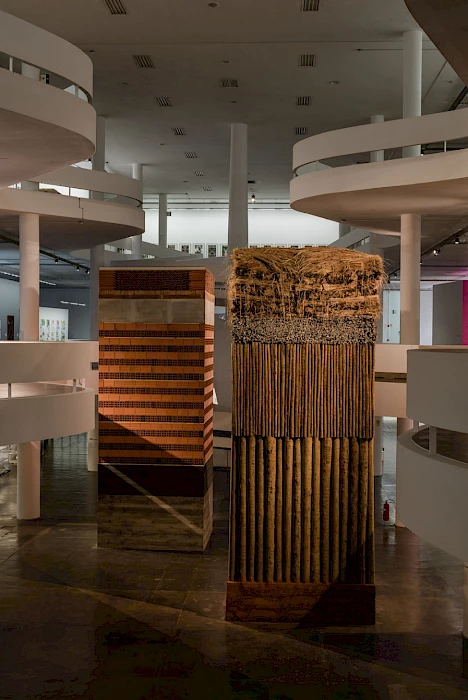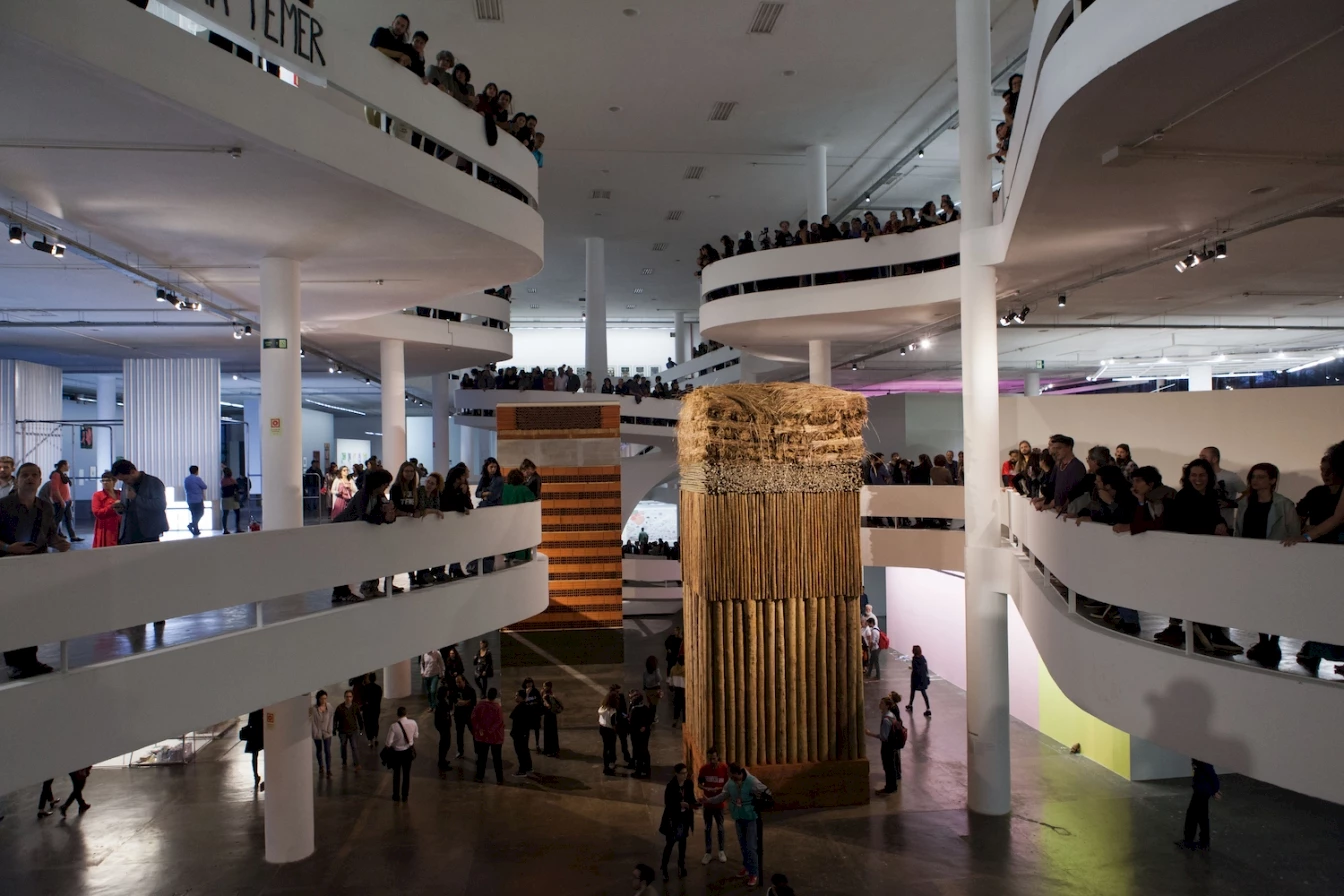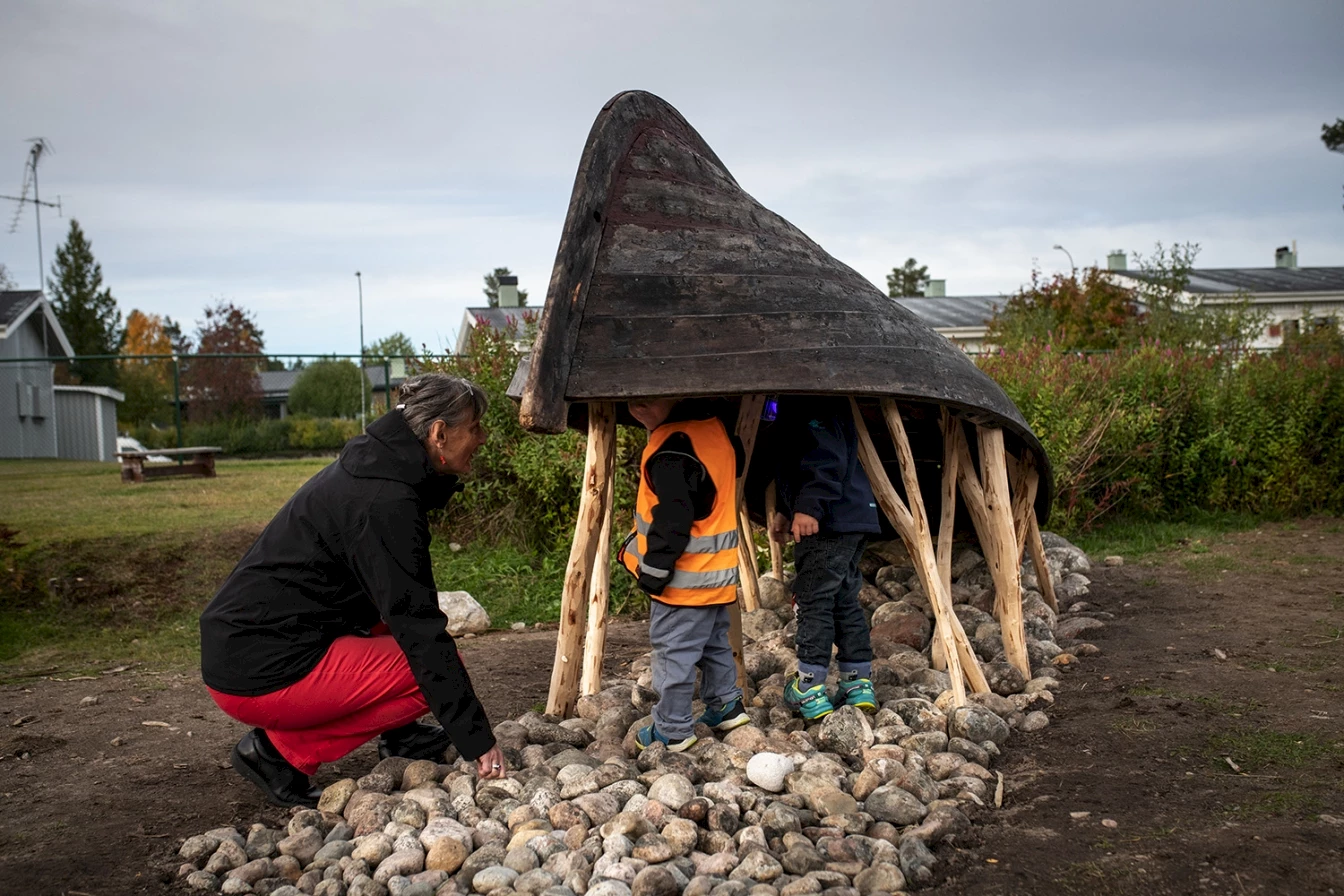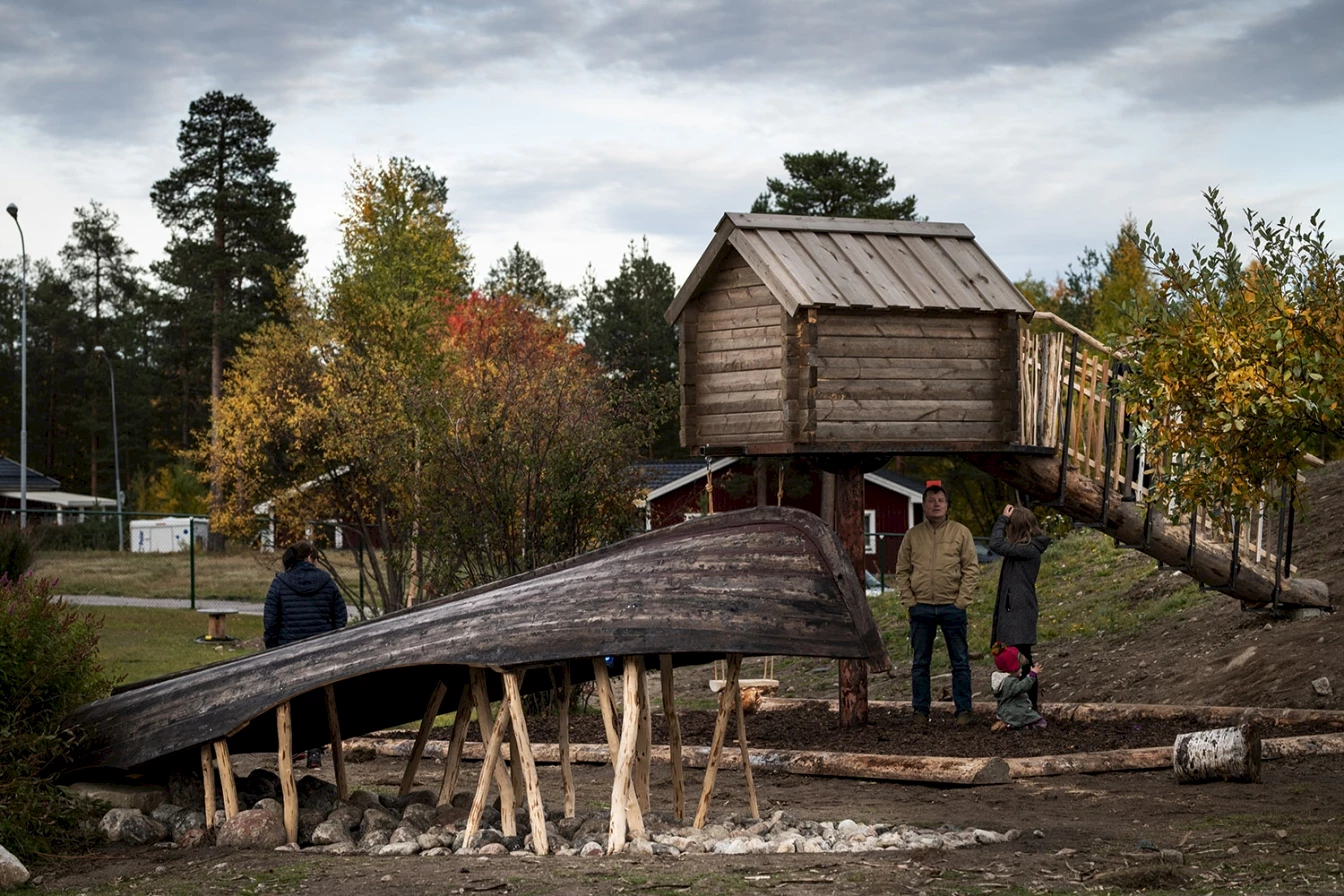
Lais Myrrha, Double Standard, 2016, woody vines, logs, straw, bricks, cement, steel, glass, pipes. Photo: Pedro Ivo Transfetti, courtesy of Fundação Bienal de São Paulo.

Lais Myrrha, Double Standard, 2016, woody vines, logs, straw, bricks, cement, steel, glass, pipes. Photo: Pedro Ivo Transfetti, courtesy of Fundação Bienal de São Paulo.
Genealogy
By trying to obscure, contradict or amplify notions of modernity, the compositions, essays, videos and architectural projects in this collection explore strategies and technologies of investigating beyond the predominantly western modernist architectural format and the main framework for today’s uncontested architectural sites.
This publication unfolded throughout an interrupted year of research, lectures and discussions. Initial plans to contextualise questions within certain sites and provoke research projects and a participatory archive failed to be realised due to the constant change of regulations amid the 2020–21 pandemic. However, the exchanges between the participants of DAAS (Decolonizing Architecture Advanced Studies), the editorial team of L'Internationale Online and the invited theoreticians and practitioners Charles Esche, Temi Odumosu, Joar Nango and Hilde Heynen, situated the driving questions of the publication and very much informed its core:
How do we approach decolonization in Europe?
How did modernism become the main, uncontested site for architecture studies and practices?
How might decolonization be enacted in museum practices?
By recognising the limits and slippages of academic disciplines such as architecture, art history, museology and curating, and encouraging practices of unlearning, we focused on situating a critical conversation around decolonization in Europe through challenging western epistemologies in relation to architecture, living and working spaces, territories of care, urban and rural planning.
The publication brings L'Internationale Online and DAAS together in a collaboration based on shared urgency in addressing decolonization within the European context. This follows a previous exhibition, conference and publication on Decolonizing North, co-edited by Alessandro Petti, Corina Oprea and Shahram Kosravi, which had the same commitment to investigating colonial histories within the Nordic region, including their ongoing impact upon the present. Furthermore, L'Internationale Online has published a series of publications that puts the need for decolonizing museum and archive practices at the core of alter-institutionality.
Today, a comprehension of colonial history and its bearing is barely existent in the European public sphere. Formal collective memory actively dislocates, quiets or rejects this history, restraining its prominence or depicting it as if it grew in isolation from an assumed fundament of European history. As an outcome, colonialism is often seen as part of a detached past. However, we cannot grasp Europe without understanding its position as a colonial power.
Colonization hasn’t ended because it still constructs civic life. In Europe, cultural institutions, museums and universities are some of colonialism’s most persistent monuments. Not only are they at the forefront of a system of representation based upon alterity and otherness, they also vigorously mutate to integrate critical challenges, extending colonialism’s temporality into the present. Hence the question Temi Odumosu offered during preliminary work for this publication: How to think and practice decolonial museum programming?

Lais Myrrha, Double Standard, 2016, woody vines, logs, straw, bricks, cement, steel, glass, pipes. Photo: Pedro Ivo Transfetti, courtesy of Fundação Bienal de São Paulo.
On Demodernizing Museums
What would it mean to generate an art museum that houses discourse through collected and displayed objects, and presents perspectives on art, modernity/coloniality rather than modern art itself? During Temi Odumosu’s lecture, Nuuk Kunstmuseum in Greenland was offered as an example of such an attempt in November 2020. In keeping with this, the genealogy of the word ‘museum’ comes to us from the nine Muses, the classical Greek goddesses of inspiration, via the legendary Mouseion of Alexandria, which was more like a university with an important library, than a place for the display of objects.
The modern museum, as a secular space for public engagement and direction through the staging of objects, is closely correlated to various institutions that surfaced concurrently in eighteenth and nineteenth-century Europe: nationalism connected with colonial expansion, democracy and the Enlightenment. Thus the importance of a focus on situating decolonization in Europe. The impact of the museum model, as an instrument of colonialism but also as a location for confined acclimatization and self-definition in spaces other than the West, are two sides of an essential denomination.
Pursuing the concept of ‘history as entanglement’ within a postcolonial articulation,1 Nuuk Kunstmuseum points towards defying historical clashes and depicting a more discerned representation of Greenlandic identity. Objects or other traces of history, such as the remains of remembrance or oral histories, function as midway points for an endeavour to recount the entangled histories between Greenland and Denmark.
The archive offers a space for the documentation of silenced histories, as well as for the scrutiny of historical colonialisms and contemporary colonialities, as prompted by Anibal Quijano.2 Arjun Appadurai affirms essential, autonomous, non-governmental archive and documentation projects as social tools and interference. Starting from these ideas, and outside the mere collecting of objects, the archive may operate as a starting point for explorations and connections of different kinds, spaces where epistemological disobedience and divergent thinking can be practiced.3
In an attempt to demythologise the narratives around artworks that are part of the museum collection, Meleko Mokgosi and his work Modern Art: The Root of African Savages, Addendum (2015) were brought into the conversation. Mokgosi’s work aims to expose the lack of contextualisation visible in the labels linking the collection’s works. Furthermore, by editing, writing over and adding comments to them, Mokgosi challenges the modernist institutional discourse within the description of artworks, and counters the ways that art history and its categorisation and linear historicisation and exclusion determine our existing rationale, understanding and vision.

Joar Nango and Anders Rimpi, Fijfere Vanás Geađgi (Burl Boat Stone), 2018–ongoing (permanent artwork). Photo: Ricard Estay.
Editors’ Notes: Architectural Dissonances
Architectural Dissonances is a collection of responsive acts travelling along trails and through sites of architectural structures as a provocation to unsettle inconsistent thoughts, beliefs and actions within norms of modernity. It attempts to draw attention to these manifestations, to observe variations and the agencies devised to affect resolutely held beliefs and values.
The collection includes essays and works by Suha Hasan, Malin Heyman, Sepideh Karami, Lais Myrrha, Harun Morrison, Joar Nango, Itohan Osayimwese, Victoria Ogoegbunam Okoye, Laércio Redondo, Ayedin Ronaghi, Emilio Distretti and Alessandro Petti.
The European colonial/modern project constructed its identity in opposition to ‘other worlds’ labelled as traditional or backward. The suppression of alternatives was, and is, an attempt to create a singular colonial/modernist canon; hence modernity cannot exist without the disqualification and degradation of other approaches and world views.
Echoing processual music terminologies, the dissonant structures and practices outlined in this collection transform, twist and interfere with the surrounding context, with the potential to change the ideologies of the fixed urban form.
Through the approach of decolonial thinking, being and doing, one question that emerges is how to fundamentally rethink, and offer ways to reimagine, society through spatial practice – beyond the utopian universalist constraints conceived within modern architecture.
Recognising the limits and slippages of academic disciplines such as architecture, art history, museology and curating, and encouraging practices of unlearning, our task is therefore to situate a critical conversation around decolonization in Europe by challenging western epistemologies in relation to architecture, living and working spaces, territories of care, urban and rural planning.

Joar Nango and Anders Rimpi, Fijfere Vanás Geađgi (Burl Boat Stone), 2018–ongoing (permanent artwork). Photo: Ricard Estay.
With Malin Heyman’s Reconstructing the Anatomical Theatre in Uppsala and her analysis of the profound relationship between racist politics and architecture, the discussion starts with a closer look at the architectural site of knowledge and the violence that sits within its thick walls. The essay Cracks in the Modernist Foundation: On the Necessity of Challenging Dominant Narratives by Itohan Osayimwese proposes an analysis of moments of transit, denoting transformation and individual identity revolution, and a critical reflection on the architectural concept of evoking correspondences between Oyotunji African Village in South Carolina, USA, and James Onwudinjo’s Adinembo House in Nigeria, in relation to architectural responses to the dichotomy between modernity and modernism, inverting, for example, colonial hierarchies of space, with a focus on the problematic legibility of colonial architecture.
Asymmetries in architecture, just as in music, are neither an immobile, inert terminus nor a reaction, rather they may perform as a syllabus of new imaginaries. Sometimes this opens up an alternate reality as an option, a model for action. It spins, interferes and denies, discloses a new surface – generously, engagingly. Works featured in this publication by Joar Nango, Lais Myrrha, Ayedin Ronaghi and Laércio Redondo reach such density. They both propose and consider a new order, inventing temporary asymmetry as an imaginary: neither rehearsal nor discharge, but rather speculation, study and prospect.

Joar Nango and Anders Rimpi, Fijfere Vanás Geađgi (Burl Boat Stone), 2018–ongoing (permanent artwork). Photo: Ricard Estay.
An archive is often regarded as proof of sorts: an ordering of historical documents that remits and accounts for evidence about societies, places and occurrences. This assessment however is inclined to obscure a critical feature of the archive and the archival process: it is not only volatile and subject to the impulses of time and history, but the material archive and the process of archiving is as much about determining the future as it is about describing the past. In the essay The Imagination of an Aesthetic Regime in the Modern Arab City: Dissent, Redistribution of the Sensible, Poetics, Suha Hasan asks: What part can the archive play in generating and supporting a critical and culturally located architecture history with the archive as both object and process? Has the lack of a complete archive of modernist architecture across North Africa and the Middle East, for example, left substantial gaps in architectural history regarding local practitioners and international epistemologies? Has this, in turn, reduced the pursuit of architectural historical research marginal to the region’s general history, current apprehensions and the future of architecture as a practice?
If the archive does circumscribe a possible hesitant horizon of commitment, reflecting rather than simply recording the past, how do architectural practices involve, negotiate, dispute and define their current liaison with the archive and the processes of archiving? What role, furthermore, has the archive performed in architecture practices across North Africa and the Middle East?
Architecture itself is an archive, a repository for cultural knowledge and, coextensively, a means of interrogating certitudes related to that knowledge. All these definitions and more are crucial to Victoria Ogoegbunam Okoye’s essay The Colonial Afterlife of Encroachment, concentrating on the colonial violence still produced and reproduced in contemporary African urban space and spatial relations, with a particular focus on Accra, Ghana.
For Walter D. Mignolo, the distinctiveness of the archive and its determination to produce knowledge defines a narrative that exceeds the status of fiction and transforms into ontological ‘reality’. To draw such contours of analysis is to suggest that the archive produces events as much as it records them. Indeed, Emilio Distretti and Alessandro Petti produce a pedagogical twist towards new practices and parameters within which future generations can approach and question knowledge in relation to fascist heritage in the village of Borgo Rizza, Northern Sicily.
In Harun Morrison’s Temporal Collage and Producing Escape: What is the relationship of modernization to boat living? the wandering, nomadic spirit becomes a visible yet disembodied entity. It is in this unstable, haunted state that a new infrastructural imprint is produced, and it is this instant that presents the artist and architect with the occasion to negotiate and rewrite, visually or otherwise, the construction of living and acting in space as a reality in waiting.
As Sepideh Karami writes in her essay Sludge: An Imagined World beyond Development: ‘A decolonized world is imagined to be a world beyond petroleum; free from the burden of politics of oil, wars, terrorism, dictatorship, colonization, environmental crisis and forced migration; a hospitable ground.’
In response, the works of the architects, researchers and artists included in this collection look at ‘infrastructural architectures’ as stories and as spaces of narrative, where locations, trajectories, buildings, ruins and canals become cross-continental networks, exposing sometimes uncomfortable intricacies of relationships.
Architectural Dissonances invites citizens in art and architecture to engage with spaces via performances and talks that re-sharpen the focus on giving form to our times.
The views and opinions published here mirror the principles of academic freedom and do not necessarily reflect the views or positions of the L'Internationale confederation and its members.